
UPDATED on Nov. 5, 2018 to correct energy data (see the extended note below).
Editor’s Note: This post is one of a series by Chris Stratton and Wen Lee, a husband-and-wife team living in the Los Angeles area who are turning their 1963 suburban house into an all-electric, zero-net energy home. They chronicle their attempts at a low-carbon, low-cost, and joyful lifestyle on their blog Frugal Happy. This post was written by Chris.
We got solar panels installed on our home on 22 April 2016 — Earth Day, coincidentally. We now have a full year’s worth of energy data since they were installed, so I thought I would look at how much energy they produced and how much we consumed during our first year of having solar.
Fair warning: This post will inevitably be pretty wonky. I’m glad to delve into technical details further in comments or elsewhere if people are interested, but for the post itself, I’ve tried to keep the wonk in check.
One of the primary goals of our home renovation project is to reduce our environmental impact by reducing the carbon emissions associated with operating the house. In addition to reducing our energy consumption through robust efficiency measures, we decided that it also makes sense to generate our own renewable energy on-site to power the house. Since we’re in the Pasadena, California, area, — with 286 sunny days per year — rooftop solar panels made sense for on-site renewable generation.
Usually it makes more sense to reduce consumption through efficiency measures (and conservation) before adding on-site renewables. Saving a kilowatt-hour (kWh) of energy through efficiency is often cheaper than generating that same kWh through a solar electric (photovoltaic) array.
However, at some point after the “low-hanging fruit” efficiency measures have been completed, the price of reducing a kWh through efficiency matches the price of generating a kWh with a PV array. At that point, it makes more financial sense to switch from reducing energy demand (efficiency) to changing the source of your energy supply (renewables). This break-even point is changing as the price of solar panels falls lower and lower.
Installing panels early in the game
In our case we knew from the beginning that we wanted a PV array, but we didn’t want to wait until after the renovation was complete before installing it. We wanted to switch to renewable energy as soon as possible, so we had the array installed before even beginning the renovation.
This meant we had to size the array before knowing exactly how much energy our house would use. We intentionally oversized the array, allowing for excess generating capacity to power potential electric vehicles and to cover the energy consumption of a more typically behaved household in the event that we sell the house later.
We had a 4-kilowatt (kW) array installed in April 2016. It went online in May 2016. It was a magic moment when got the go-ahead from our utility and switched the inverter on, and saw the digital readout telling us that we were sending power back to the grid because we were generating more electricity than we were using. From June 2016 until June 2017, our house (and its occupants) consumed 1747 kWh of electricity. During the same period, our PV array generated 5920 kWh, 339% of what we consumed.
But of course, electricity is usually not the only form of energy that a home consumes. In our case, we also consume natural gas, which we use to heat our water. During the same period, we used 58 therms — or 1699 kWh — of natural gas. This brings our total household 12-month energy consumption to 3446 kWh. The 5920 kWh of generation represents 172% of our total consumption; we generated more than 1.5 times what we consumed. There are more thorough and complex performance metrics that can be used (site vs. source energy, kilograms of carbon dioxide equivalent averted, adding water consumption, etc.), but for now, this is good enough.
We generated more energy than we consumed for ten out of the 12 months, with January and February being the exceptions (not surprising, as these are the months with the least amount of sunshine).
Consider grid-scale renewables, too
These days, homes that generate as much energy as they consume — so-called “Zero Net Energy” (ZNE) homes — are all the rage. And not without reason. It’s great to be able to tell people you live in a ZNE home, even if there’s inevitably a tinge of smugness and superiority entailed in doing so.
Another approach that’s functionally equivalent, but not as easily bragged about, is to purchase grid-delivered electricity that is generated at a large-scale PV or wind-turbine facility far away. This is a good option for the large number of households for whom on-site generation doesn’t make sense, and in fact it’s likely more efficient (and cheaper) than on-site PV because it makes better use of economies of scale.
From my perspective, interacting daily with the equipment and forces that generate the energy that you use makes all the difference. It removes some of the abstraction of the grid as an unseen, far-off place, and makes the use of energy a little more relatable.
The new normal?
In time, I think ZNE homes will just be referred to as “homes” — meaning that every, or nearly every, home eventually will become ZNE. California is already on this path.
I am curious to see how our home’s generation vs. consumption changes as the renovation gets closer to completion. Our first 12-month period of having solar is a little unusual because our house is a construction zone. We’re running power tools for hours on end, but we also don’t have any central heating or cooling system (we use a space heater and portable air conditioner). We don’t have an oven, but also the house is not well insulated … all that to say, there are a lot of balls in the air right now, so it’s hard to guess whether our overall consumption will be significantly different once the renovation is complete.
We’re replacing the gas water heater with a heat-pump model that should use significantly less energy, but we’re also adding a whole-house space conditioning system, new kitchen appliances, etc. Who knows which way it will all wash out. I suspect that after everything is done we’ll use about as much energy as we do now, or slightly less, but we’ll be much more comfortable and have a lot more services.
The more important thing is that after the renovation, whoever lives in this house will likely use a lot less energy than they would living in a typical house. Frankly, it doesn’t really matter that much where we live — we will always be low energy users. It’s just the way we are. The real energy savings and carbon reduction potential comes from the (normal) people who don’t think about energy or climate constantly — they are the people who use the energy and whose reduced consumption will make a big difference.
UPDATE: I recently discovered I had been reading my electricity bill incorrectly and had to revise my calculations. The post has been updated accordingly.
Turns out I had been reading my electricity bill incorrectly. I presumed the consumption and generation numbers on the bill were gross amounts, but discovered recently that these numbers represent the cumulative net amounts (e.g. If the bill says we used 76 kWh of electricity in a month, this number includes the amount offset by the solar panels, so our consumption was actually higher than 76kWh).
Likewise, when we were exporting energy, the exported number on the bill has already had the consumption subtracted from it. In short, the utility bill is good for keeping track of how much money we owe for energy and how much they owe us, but incredibly there’s apparently no way to determine from the bill how much total energy we’ve consumed and generated.
To retroactively determine the actual consumption and generation, I found a way to download the raw generation data from our PV meter and used these with the bill figures to calculate our actual consumption and generation data (seriously, why is this so hard?). I’m embarrassed to report that we had overstated our conservation badassery in the first version of this post (our energy use is low, but not as insanely low as previously reported).
I’m also happy to announce that our solar panels generate more than we previously thought (and more in line with their predicted generation). In the end the net consumption number is about the same. In the spirit of accuracy and integrity, I wanted to make sure to update this post with the revised numbers and charts. Apologies for the confusion and thanks for putting up with science in motion. We’re all still learning.
Other posts by Chris Stratton and Wen Lee
- An Introduction
- A Car-Free Experiment
- Demolition
- Our House Becomes a Giant Foam Box, Part 1
- Giant Foam Box, Part 2
- Let’s Kill the Lawn
- Vaulting the Ceiling
Weekly Newsletter
Get building science and energy efficiency advice, plus special offers, in your inbox.





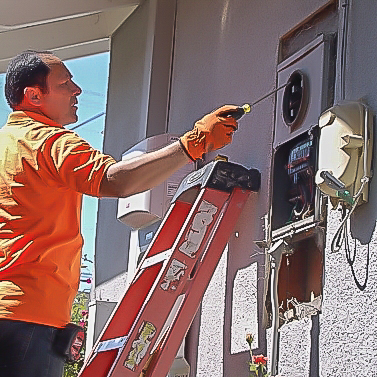
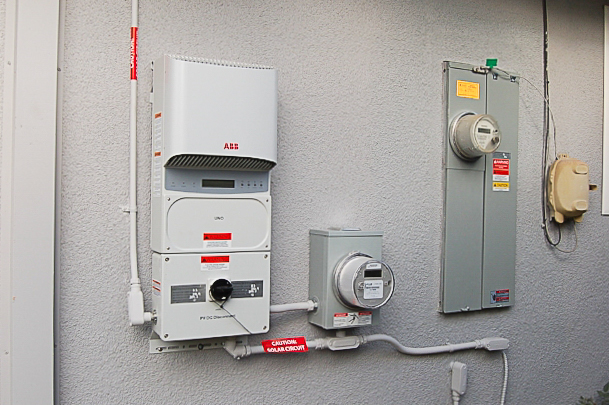

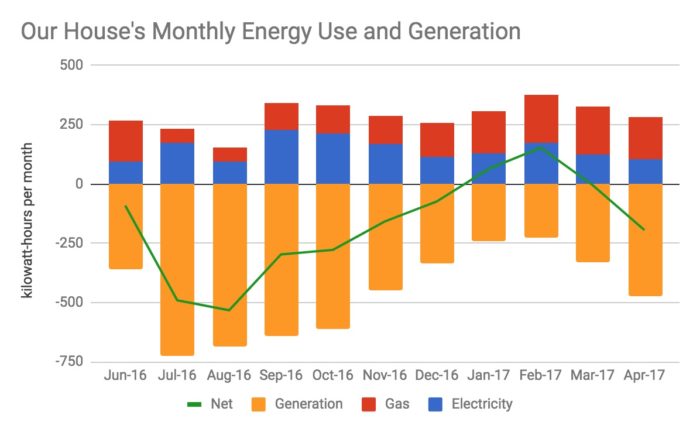

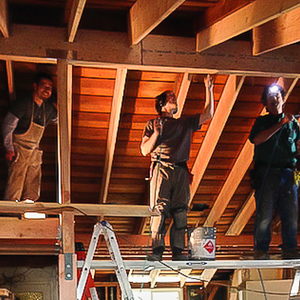
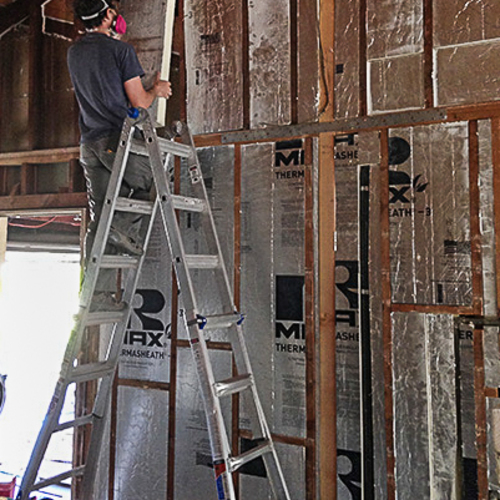
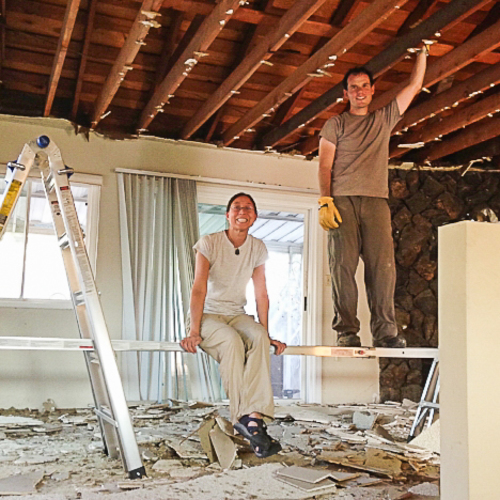






10 Comments
913 kWh per year electrical consumption is amazing. Just a little over 2.5 kWh per day, 100 watts per hour on average. I contract with an electrical utility company working with their customers on high bill complaints. It's not uncommon for me to see 5 times your yearly usage in one month. Lifestyle choices have a lot to do with reducing electrical usage, but what energy saving measures (low hanging fruit) were implemented in your home?
76kWh a month is incredible. My fridge uses 27.5kWh/month and my heat pump dryer uses 11kWh/month per person. Just the router uses 4.4kW/month and thats in low power reduced function mode. Add in my LED lights and a few uses like the microwave and my average without dehumidifier or furnace or air conditioning is about 100kW/month. With them is ~225kWh/month annually averaged, my house is very inefficient and expensive to fix :(
I expect that with a heat pump water heater your consumption will be going up not down unfortunately. That said your still doing awesome, your probably using less power now then most people in the USA. Though i am curious your AC use, was it intermittent because of construction?
Congrats on doing a good job with your remodel. Having said that, for other folks around the country, the idea of installing 5.4kWh system, when a 3kWh system would have done the job is mind-blowing. Spending an additional $7-9k on an over-sized system, at those consumption rates, it will take years to recoup, without a 100% true net metering, which I doubt any utility company will give that much credit. A good system sizing and calculations should be in order.
That is insanely low power usage. I think we used 450kWh last month. Just cooking, washing clothes, showering every other day, powering a laptop and charging phones. No heating or cooling. I can't even imagine how we could reduce it.
@ Armando wrt installing an oversized solar system: I suspect that an electric vehicle would use a fair amount of that extra capacity, and in California in particular an electric car is not a farfetched probability.
I'm with the others - absolutely in awe of your low power use. I live alone, I'm in a recently built, *very* well sealed and insulated home also in So Cal, and my lowest months of use are still in the low 300 kWh range. With AC running, during the hottest months, I'm around 700 kWh.
My refrigerator is from around 2004. I looked up its power use previously and I think it was around 55 kWh per month. That's around 2/3 of your total electrical use alone!
I don't know why everyone is so surprised about the consumption given the climate "Csb". (Mediterranean Climate) is essentially ideal for this type of work.
The loads I mentioned are completely irrespective of climate.
And I'm probably within 40 miles of Chris and Wen, in what's likely a similar environment (near Irvine and Tustin, CA.)
I really enjoy Chris and Wen's blogs. Apart from realizing that there was perhaps more physical labour involved than they had thought, their goals were clear, no real unanticipated problems and a great result.
Log in or create an account to post a comment.
Sign up Log in